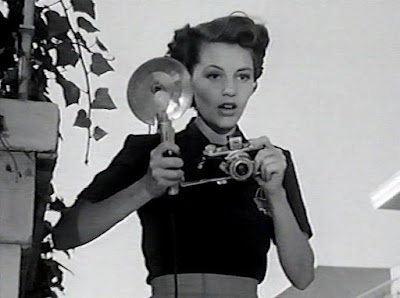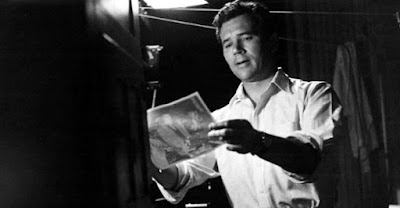 |
Ted de Corsia, "The Naked City" (1948) — just one of the 8 million stories. By Paul Parcellin |
Maybe it was the rigors of World War II that whet the public’s appetite for true crime stories in the 1940s. Returning soldiers, who saw real blood and guts on the battlefield, were less than inspired by movies based on fictional stories, or so the legend goes. They wanted a realistic view of life that matched the bleakness of their combat experiences and the changing peacetime world.
Movie audiences, accustomed to the realism of wartime newsreels, liked the immediacy and authenticity of short films featuring real troops engaged in combat and other current events.
At home, urban crime was on the rise and cities were deteriorating. The spate of semi-documentaries, which at first glance appeared to be as credible as legitimate news sources, validated the public’s worst fears about the decline of urban life while usually offering an upbeat message of hope.
Some of the films of that era that mimicked the look of documentaries include “The House on 92nd Street” (1945), “Boomerang!” (1947), “T-Men” (1947), “Highway 301” (1950) and “The Hitch-Hiker” (1953), to name just a handful.
Some were merely inspired by true events while others stuck closer to the facts. Often, they were composites of different true cases blended into a single storyline. Most featured voice over narration in some form and they sometimes shot scenes in the exact locations where the real events took place.
 |
| Tom Pedi, Nicholas Joy, Barry Fitzgerald, David Opatoshu, Howard Duff at police headquarters. |
As the investigation wears on and leads begin to fizzle he’s undeterred and pursues promising angles with zest. It’s as if he has an unshakeable confidence that the perpetrators are bound to fall out of one of the trees he’s shaking. His self-assuredness and lack of cynicism is hard to figure considering the tough environment he’s in and the hardened criminals he’s after.
His counterpart, the young, green homicide detective Jimmy Halloran (Don Taylor) is assigned every shoe leather task that needs doing. He’s resigned himself to a life of diving into haystacks in search of elusive needles, for the time being, anyway. Theirs is a dynamic we’ve seen replayed in countless films and TV shows, but back then it must have had a fresher feel.
 |
| Robert H. Harris, Don Taylor as Det. Jimmy Halloran, doing his shoe leather work. |
Voiceover narration by the film’s producer Mark Hellinger, the stuff of documentary-style storytelling, works sometimes. But too often he reaches for comic relief and stumbles, and just plain talks too much. Never mind, the movie looks great and proceeds at a fast enough clip.
 |
| Arthur Fellig, A.K.A. Weegee |
Obviously, director Jules Dassin wanted the film to deliver the grubby truth as seen in the lurid photos and screaming headlines of tabloid journalism. We occasionally see visual touches that remind us of Weegee’s work, such as kids cooling off in the spray of an open hydrant. We also get a touch of his signature gallows humor when other youngsters dive off the East River dock only to find a corpse afloat there — innocence of youth, meet the grim reality of big city criminal culture.
Retaining the Weegee aesthetic, the film’s lensman, William Daniels, captures New York City’s tight, claustrophobic niches as well as its sweeping skyline and the odd vignettes of ordinary folks on the street in mock cinema verite fashion.
A master of black and white photography, Daniels shot 21 films starring Greta Garbo between 1926 and 1939, including “Mata Hari” (1931), “Grand Hotel” (1932), “Queen Christina” (1933), “Anna Karenina” (1935), “Camille” (1936) and “Ninotchka” (1939). In “The Naked City” he somehow makes the gritty urban landscape of 1940s Manhattan lushly beautiful, transforming the grimy sprawl of Manhattan’s underside into a character in its own right. Had the producer dropped a good deal of the film’s voice over and simply let the pictures tell the story the film would be stronger for it.
Voice over doesn’t get in the way of actors’ performances so much. The film presents Garzah, for instance, as a criminal without redeeming qualities. He places little value on human life and would just as soon pull a trigger or pitch a drunken man into the drink when he feels threatened. His ethos of survival at any cost comes to a head at the film’s climax, being chased by the cops he climbs the Williamsburg Bridge’s steel supporting structure. It’s a setup for the cinematic takedown of a big man, a la James Cagney’s fireball of a final scene in “White Heat” (1949), when the hunter becomes the prey and the prey gets flambéed. Garzah’s end is a good deal less flamboyant, however.
 |
| Ted de Corsia as Garzah on the Williamsburg Bridge. |
What seems utterly credible, however, is the primitive crime fighting technology we see. Halloran, the man in the field, needs to find a pay phone to call the precinct with critical information about the man he’s tracking down. The desperately inadequate communications system he’s got to work with is responsible for a disconnect that puts the young law officer in trouble. Before attempting to singlehandedly bust the bad guy, Halloran leaves a phone message — yes, a phone message — for Muldoon who is out of the office. The police department desk jockey almost forgets to pass the crucial information on to the lieutenant, so when the junior detective lands in hot water there’s no cavalry there to pull him out.
Things eventually work out, but that caused me consider this: In pre-cell phone days, screenwriters must have had an easier time whipping up dramatic tension. With tracking and cell phone towers, a law officer is probably less likely to become isolated and in jeopardy. How many plot twists can hinge on depleted batteries and lack of signal? A lot, apparently. Things were just simpler in the old days, but I digress.
As 1940s docudramas go, “The Naked City” is a solid piece of construction with a few creaky floorboards. See it on a big screen if you can — it’s a paean to a New York that has largely been lost to time.

















